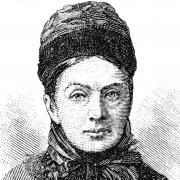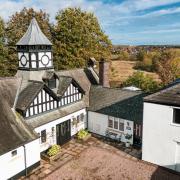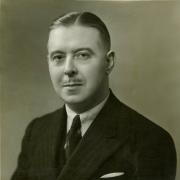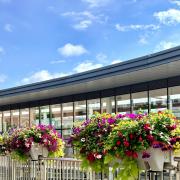Macclesfield’s Paul Lloyd found a new lease of life in painting, and now his Manchester cityscapes grace walls around the world.
Unlike most careers, there is no best before date in art. The retirement age isn’t set at 67, younger colleagues don’t start looking at you and wondering when you’ll move on and make way, your experience isn’t overlooked by the arrival of bright new things and the march time is a gift, not a worry. Artist Paul Lloyd is aware, and grateful, for this and has at last found a balance he loves.

“I grew up in Manchester,” he says, “and left at 18 to study graphic design. I did a four-year degree course and when I finished, suddenly everything changed. When I started, there was a real skill to the job and computers just came in when I was in the final year of my degree course, and suddenly the job I was trained to do was made redundant. It was a case then of learning Apple Mackintosh desktop publishing as it was called in those days, which was great, but I didn’t enjoy the mechanics of the job so much.”
In the early 90s Paul came back to Manchester and started his own business, in print and exhibition design, but in 2009 his life changed overnight again, as the financial crash took his business with it, leaving him reeling.
“It was a watershed moment,” he says. “I decided that I wanted to do something for myself. I needed to do something for me. I thought, well, I was always good at art at school, so I decided to go to life classes. It was all going back to basics – how to draw, anatomy, basically starting from scratch.

“I really enjoyed it. It was very cathartic for me, because it took me out of my troubles and where things had gone wrong. It just consumes you when you’re doing a life drawing, you just fully concentrate on the thing that you’re doing and there’s no room for other thoughts.
“It was then that I started painting, as I was painting in the classes. I had a fantastic tutor, who was classically trained, which is unusual today. He basically taught me how to paint, which is something you don’t really get in art school, ironically. I’ve met so many fine art students who tell me nobody tells you how to paint, the fundamentals, you have to learn it yourself.
“The skills and disciplines I learned in life drawing and life classes, in terms of how to look at a subject, how to extract what was important and what wasn’t important, the very subtle differences in tone that can make such a massive difference. That got me very interested and it was a case then of deciding to try to make something of this.”
Paul found representation with De Lacey Fine Art, in Manchester, which has now sadly closed, but it was many years before he plucked up the courage to put his work in front of a gallery at all.

“For a long time I resisted the thought of trying to get into a gallery, because I still thought I wasn’t particularly good, not good enough for a gallery. As I kept painting, I found a great love for painting buildings and from doing various sketches in Macclesfield to the cityscapes of Manchester.
“The Manchester scenes really suited me. I worked there for 20 years, so a lot of the images are burnt into my memory, really, and I was always fascinated with the Victorian buildings that are still standing. I find them so interesting; I was really drawn to the earthy tones of the brick and the stone, and the terracotta. They are so diverse, there are lots of things to consider like the windows and balconies, and of course the contrast with all the buildings springing up now.
“Also, I think, it’s a a case of really wanting to document it, as well. Hopefully if some of my paintings are still around in 20- or 30-years' time, there will be a sense of nostalgia – all the cars will look old, the fashions will look dated, the shop fronts and brands will have moved or gone, but the buildings, they stay the same, as they have now for 200 years.”
It wasn’t until 2021 that Paul decided to approach galleries and see if they liked his work.
“As an artist you’re always told never to just walk into a gallery with examples of your work, that gallery owners don’t like it, they’re just bombarded all the time. In 2021 I just felt I was ready, I felt more together. I emailed a couple of galleries, but both had rejected me, so one day I just thought I’m going to go in. Looking at work online it can be completely different to how it really is, so I got three or four pieces together and took them in to Gordon at De Lacey Fine Art.

“He was very kind, agreed to have a look, and then just sat on the floor with them all propped up and didn’t say a word for about five minutes. I was thinking ‘this isn’t going well’, and then he turned round and said yes. It was a really great day.
“I sold well, my work has an appeal not just to people who live or work in Manchester, but to people who used to live there, for work or as students, who have that connection to the city and the iconic buildings. A lot of foreign students like to take my work back with them, a summary of Manchester while they were there.’
Paul starts each new piece with an epic photography session in Manchester, having carefully chosen where he’s going to go.
“I find a little research in advance helps a lot. I need to decide if I am going on a rainy day or sunny day. I need to know when the buildings I am interested in get the sunshine, or the best light on a wet day. I take 200-300 photos, and then will select just one or two. I do quick sketches and take notes about the colours I see. Photos don’t reproduce what I actually see, so I will write down the three colours I would use to create a particular shade.”
After 2009, Paul stepped away from graphic design, and settled into a more prosaic, but less stressful, role at a nearby supermarket. He now works part-time here, giving the rest of his time to his art.
“It’s lovely,” he says. “I enjoy my work at the supermarket, the people are lovely, but it was a real change to my life and it took me a while to get my head around it, coming from such a creative role. I now really enjoy the two sides to my life; there’s a social life around work, whereas painting is very solitary. I enjoy that balance; to do it full time would be difficult for me, I think.”




























